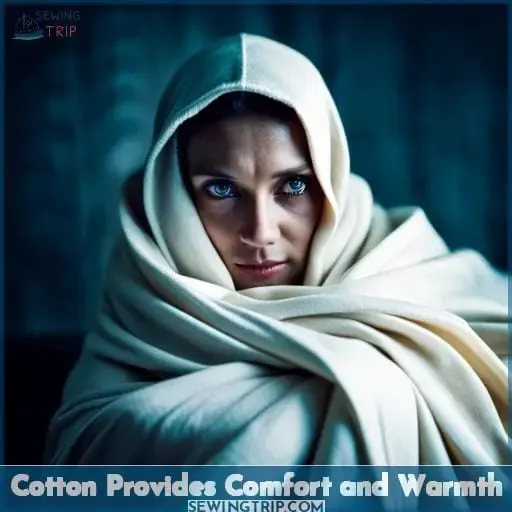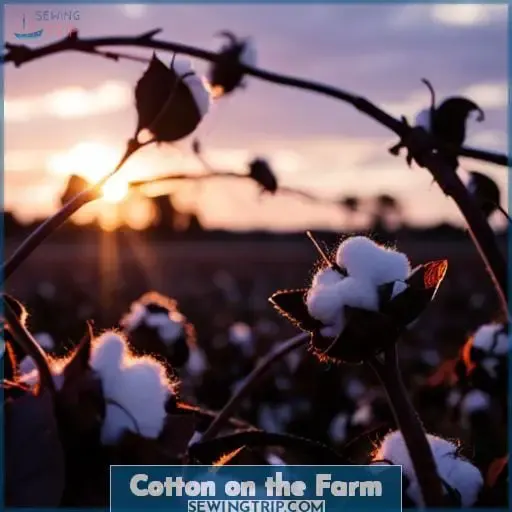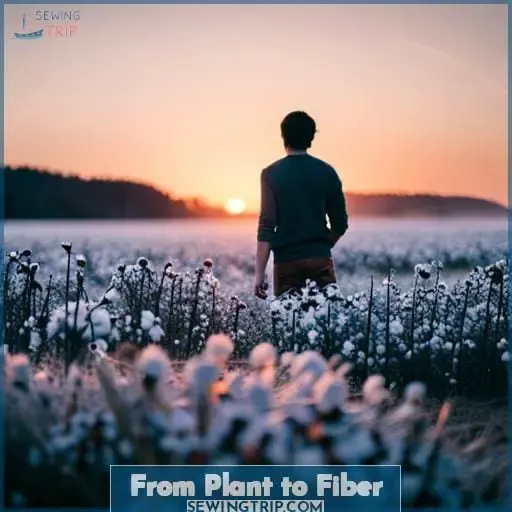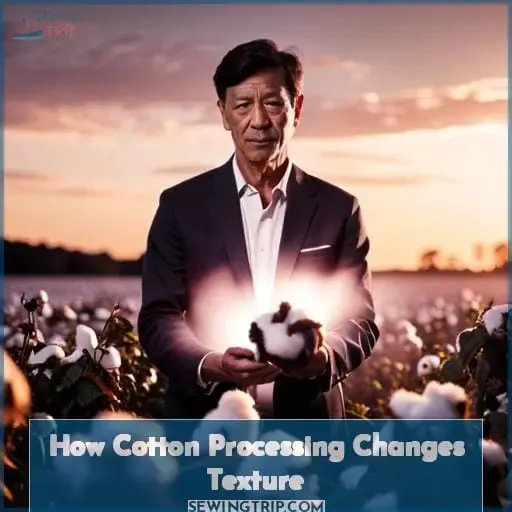This site is supported by our readers. We may earn a commission, at no cost to you, if you purchase through links.
 You’re between the sheets, nuzzling into the soft embrace. You feel the cool, crisp fibers against your skin, sending a wave of relaxation through your body. The cotton’s breathability keeps you cozy yet fresh. It’s your home away from home, your safe haven.
You’re between the sheets, nuzzling into the soft embrace. You feel the cool, crisp fibers against your skin, sending a wave of relaxation through your body. The cotton’s breathability keeps you cozy yet fresh. It’s your home away from home, your safe haven.
As a textile engineer, you understand the science behind cotton’s comfort. Its natural fibers bend and flex with your form. You’ve felt cotton’s potential firsthand, now it’s time to share that gentle touch with the world.
Table Of Contents
Key Takeaways
- Cotton has a range of textures based on type, processing, and weaving, which affects its softness, durability, and breathability.
- Cotton production evolves throughout the growing season as the plants mature and the bolls burst open with fibers.
- Processing transforms the texture of cotton through cleaning, carding, spinning, and weaving, altering how it feels.
- When choosing cotton by feel, touch various fabrics to find your preferred softness, durability, and breathability.
The Many Textures of Cotton
Some types of cotton can have an incredibly soft and fluffy feel that provides exceptional comfort, while other cotton varieties may seem coarser and rougher to the touch before manufacturing. Certain cottons, like Pima or Egyptian, start with longer fibers that become smoother with washing.
The softness depends partly on processing too – fuzzy flannel cotton gets its texture from brushing, while lightweight voile gets a gauzy feel from very loose weaving.
With so many options, cotton’s range of textures allows it to be fashioned into everything from sturdy denim to silky sheets.
Cotton Provides Comfort and Warmth
You’ve explored cotton’s varied textures and processing methods. Now we see how cotton provides comfort and warmth.
- The comfort of flannel sheets
- Lazy days spent in cotton pajamas
- The versatile durability of jeans and jackets
- The cool breathability of t-shirts
- The evolution of sensations on the farm
- Hard, full cotton bolls bursting with soft fibers
Cotton’s ability to insulate or breathe makes it the fabric of cozy Saturday mornings and cool summer nights. Its soft fibers offer a welcoming embrace. Cotton gives us the gift of comfort wherever we go.
Cotton on the Farm
Although cotton provides comfort and warmth in finished products, you’d experience different sensations when growing it. On the farm, cotton transitions from tender young plants to mature bolls bursting with soft fibers.
| Early Season | Mid Season | Late Season |
|---|---|---|
| tender plants | smooth leaves | hard bolls |
| fuzzy leaves | crinkly flowers | bursting bolls |
| firm stems | firm seeds |
The sensations evolve throughout the season. Tender plants become hardy and strong. Fuzzy leaves turn smooth and then dry and crinkly. Empty bolls harden and fill with soft fibers.
lane, pilot, trophy, picnic, sweater
From Plant to Fiber
From seed to spun yarn, cotton undergoes changes throughout the season. We’ve seen how the plant produces irresistibly soft fibers we all love. The journey from seed to spun yarn reveals cotton’s true character. Fibers burst forth, eager to be harvested.
We card and comb, softening and straightening each strand, nurturing cotton’s potential. Only through this transformation does cotton develop its beloved texture. Slick yet grasping, cotton embraces our skin with its delicate strength.
Cherished for comfort, cotton rewards our attention with velvety renewal.
How Cotton Processing Changes Texture
As we transition from learning about cotton’s journey from plant to fiber, let’s explore how processing transforms cotton’s texture. My friend, cotton’s texture evolves dramatically as it’s cleaned, carded, spun, and woven.
The soft fibers become yarn, the yarn becomes fabric with surface interest. Processing makes cotton ideal for clothing, bedding, and even household goods. Cotton processing is magical, really, turning raw fibers into infinitely usable textiles.
Now, let’s continue our cotton education by examining exactly how processing alters cotton’s tactile qualities.
Choosing Cotton Products by Feel
The texture of cotton changes during processing. Consider how sheets, t-shirts, and towels feel.
Cotton Types Vary Softness
You’ll find that different cotton types, like Egyptian or Pima, vary quite a bit in softness and feel. Choosing the right cotton product for your needs starts with understanding texture preferences. Cotton’s softness and feel can differ greatly depending on the type. Egyptian and Pima cotton are known for extra softness and comfort.
Other types may have a courser texture. Consider what you hope to get from the cotton item – lightweight and breathable, smooth and soft, durable, easy to clean. Touch fabric samples in person when possible. Understanding the range of cotton textures will help you select products you’ll truly enjoy.
– Processing Affects Texture
Cotton products can be chosen for their feel since processing affects softness and texture. Denim cotton lasts, flannel cotton warms, percale cotton cools, terry cotton absorbs, and knit cotton breathes.
– Consider Cotton Origin
With cotton’s texture varying by origin, you would select sheets made of Egyptian cotton for their famously luxurious feel. Cotton grown in Egypt is prized for its extra-long staple fibers that yield an exceptionally soft, smooth hand.
The long fibers can be spun into finer threads, resulting in a higher thread count and a silkier weave. While many factors influence a sheet’s feel – such as thread count, weave, and finishing treatments – the provenance of the cotton remains paramount.
Of all cotton types, extra-long staple Egyptian cotton produces the most supple, durable bed linens.
Conclusion
You run your hands over the soft cotton shirt, feeling the fluffy texture against your skin. The pliable fibers bend and flex with your movement, enveloping you in cozy comfort. Cotton carries you back to simpler times—sunny days spent in cotton sundresses, snuggling in cotton pajamas during movie nights.
Its soothing touch reminds you of home. What does cotton feel like? A hug from an old friend.












